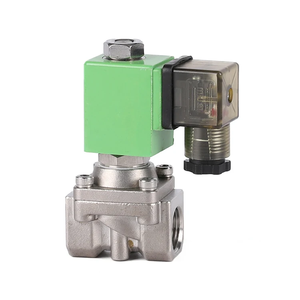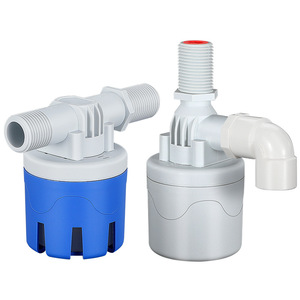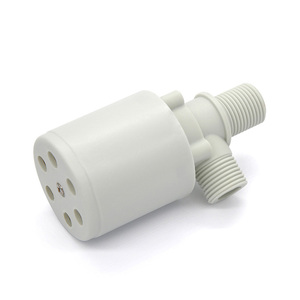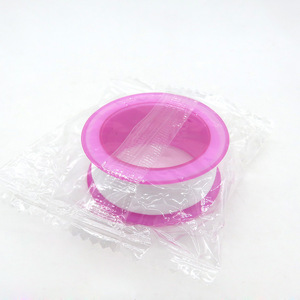
All categories
Featured selections
Trade Assurance
Buyer Central
Help Center
Get the app
Become a supplier

(5031 products available)








































Water level control valves have several types, each adapted to different placing and uses.
Floating Valve
A floating control valve is mandatory because of its efficiency in automatic adjustment of liquid levels in large repositories. This valve integrates a floating ball or a plug that moves up or down in order to seal off or permit fluid passage through the outlet as the liquid rises or drops within a set limit. Common uses of floating control elements are usually located in water tanks, reservoirs, and treatment plants.
Electronic Control Valve
Electronic water control level valves are properly and manually searchable valves that feature sensors and electronic circuits for precise water level monitoring. These valves allow for better control of the input and output flow, reducing wastage and providing accurate water levels. These types of valves are significantly used in industries where there is scarce room for error and precise control is a must in such places as pharmaceuticals, semiconductor manufacturing, and food processing.
Pressure Balance Valves
Pressure balance control valves work on differences in pressure. They maintain the liquid level by balancing the pressure at the valve inlet and outlet. As the liquid level rises, the increase in pressure at the outlet closes the valve, reducing the outflow. These are usually found in reservoirs and are well used in mining, and water redistribution in remote areas.
Hydrostatic Valves
Hydrostatic control valves work closely with pressure balance valves but use hydrostatic pressure differences instead. They are good at level sensing and work best in high-pressure applications. Ideal working conditions incorporate large water tanks in chemical plants or underground facilities.
Float Switch Valve
A float switch valve incorporates a float and a switch which moves when the water reaches a certain level. It can be designed to open or close a circuit, activating or deactivating pumps or alarms due to the position of the float. They are common in sump pits, and water feature systems, which helps to encourage pumping actions or shut downs when the water levels go too low or too high.
Water Valves have many related materials and durability attributes that affect performance and longevity.
Corrosion Resistance
As water is likely to be the most fluid that is worked by these valves, the formation of rust or any other form of corrosion is very bad for water valves after a while. Common materials used include brass, stainless steel, and plastics that have low risk or no risk of corrosion. Stainless steel is often used in marine or wastewater treatment plants where water might contain corrosive substances.
Wear Resistance
This ensures that the parts of the valve do not get worn or torn due to continuous friction, especially seen in areas where the water contains abrasive particles, such as in mining or agricultural irrigation. Wear-resistant materials such as ceramic coatings or hardened metals are employed in such conditions. This extends the life by reducing wear on internal components and thus maintaining functionality in the long run.
Temperature Tolerance
Water level control valves are designed to withstand a wide range of temperatures, both high and low. In such cases where water is likely to be heated or is in a batch process where fluids are circulated at different temperatures, materials that have high thermal stability such as synthetic seals, and special alloys, are a must. This is to ensure that there is no material breakdown and that there is constant control of the water levels.
High-Pressure Resistance
In the case of hydrostatic and pressure balance control valves, the materials used must be able to withstand great amounts of pressure. Usually, brass, stainless steel, and specially designed alloys are used to manufacture them. These materials possess enough strength to retain their shape and functionality, even when subjected to pressure for long durations.
Sealing Materials
Seals and gaskets are made with elastomer materials like Viton or Nitrile rubber. Because they are synthetic rubber, they can resist water, heat, and chemicals, thus preventing water leaks in the valve. As these materials tend to degrade over time, they are then replaced at intervals, which makes the valve last longer and function better. Regular replacement also adds to the longevity of the valve and keeps it in good working condition.
Water Source and Pressure
As there are many different kinds of water level control valves, and as not all of them can be appropriate for every kind of water source, it is important first to assess the water source and available pressure. In the case of natural water bodies, for example, a floating ball valve would be ideal. Because these are best used in large open water surfaces like lakes and reservoirs. In the case of high-pressure applications, a hydrostatic or pressure balance valve But would be more suitable, as these are designed to handle high pressures. Electronic valves would work best in controlled environments where accuracy is required, such as in industrial processes.
Water Quality
The quality of the water greatly affects the water level control valve to be used. For instance, chemicals that are likely to corrode have a chemical nature and will thus require a chemically resistant material. This can be found in the electronic control or stainless steel control valves. For areas where water has particulate matter or is abrasive, then search for a valve made of wear-resistant material., This could be a valve with ceramic coatings, as other ways are likely to be destroyed by the particles in the water.
Tank or Reservoir Size
Here, the size of the tank will determine the type of valve that will be necessary. In the case of small tanks or pits, a float switch valve will do the trick since it can give manual control. Electronic control valves are also suitable for small and large reservoirs where precise control is required. For large reservoirs or open water bodies, floating ball valves are more suitable due to their automatic functions.
Installation and Maintenance
Maintenance and accessibility during the installation should be taken into account when choosing a water level control valve. For hard-to-reach places, a maintenance-free valve, such as a float valve, is often more appropriate. In this case, electronic control valves may need regular electronic checks, which may not be ideal for remote areas. Installation should also be simple and without complications so as not to waste time during the process. Some valves come with mounting brackets and adjustable lengths to make the installation easier and faster.
Water Treatment Facilities
In a water treatment plant, water level control valves are used to avoid dry pumping and make sure that the water levels stay constant in tanks and basins during treatment processes. It helps with the right water levels during treatment processes, which helps give water of the right quality. Without these valves, water levels would either become too high or too low, affecting the chemicals used and the treatment processes.
Irrigation Systems
Water level control valves are also used in agricultural irrigation systems to supply crops with the right amount of water. They are used to maintain water levels within irrigation ditches or canals, giving a steady supply of water to the fields. With these control valves, the right amount of water is supplied to avoid both waterlogging and drought. This makes sure that crops get just the right amount of water for growing, which increases production and keeps quality high.
Wastewater Management
Water level control valves in wastewater management are responsible for preventing overflow in sewers and treatment ponds. They help in the regulation of the water levels in the treatment plants to encourage the proper functioning of the microorganisms that treat the waste. By avoiding overflows, these control elements also help avoid the pollution of the environment by wastewater. In their absence, then the chances of overflow are high, which will lead to the pollution of the environment and thus disrupt the ecosystem.
Flood Control Systems
Water level control valves are the main features in flood control systems. They help to monitor water levels in rivers and reservoirs to prevent floods by opening or shutting up the movement of water. This means that the pressure would not cause any flooding, especially during the rainy season. Without these valves, there would be no effective flood control, and this would lead to the higher possibility of flooding and therefore damage to property and loss of life.
Industrial Processes
A lot of industries use water level control valves to keep the water at the right amount used in different production processes. They are used in cooling systems to maintain water levels in cooling towers and reduce the temperature of machines. These control valves are mainly used in the production processes that require a constant level of water, such as dilution, washing, and chemical reactions. Without these control valves, the water levels would not always be at the right level, affecting the production processes and possibly damaging the machines due to overheating.
A: This is a valve that regulates and maintains the level of water in a certain certain area. It helps to keep the water levels stable and constant, automatically adjusting the input and output flow based on the current water level.
Float switches are used to simply detect the water level and signal an action, while water level control valves actually control and adjust the flow of water to maintain the desired level.
Water level control valves are used in many industries, including agricultural irrigation, water treatment and wastewater management, flood control systems, chemical manufacturing, and power plants.
There are water level control valves that are designed to withstand high temperatures, and these are called water control valves that are suitable for hot water and high-pressure applications. These valves are especially useful in industries that use water for cooling or as part of a chemical process.
The frequency of maintenance depends on several factors, including the environment, water quality, and the type of valve. In general, routine inspections should be performed at least once a year. However, in harsh environments or high-demand situations, more frequent maintenance may be required.